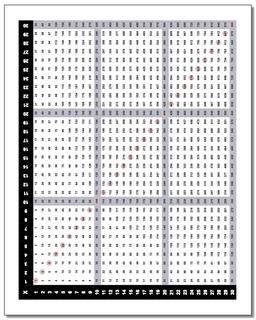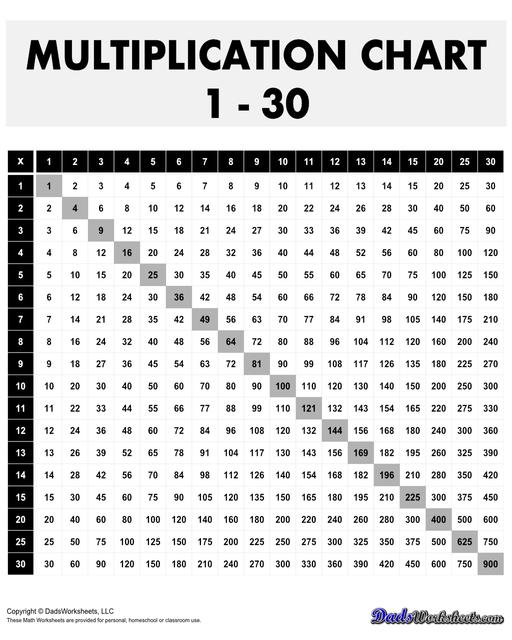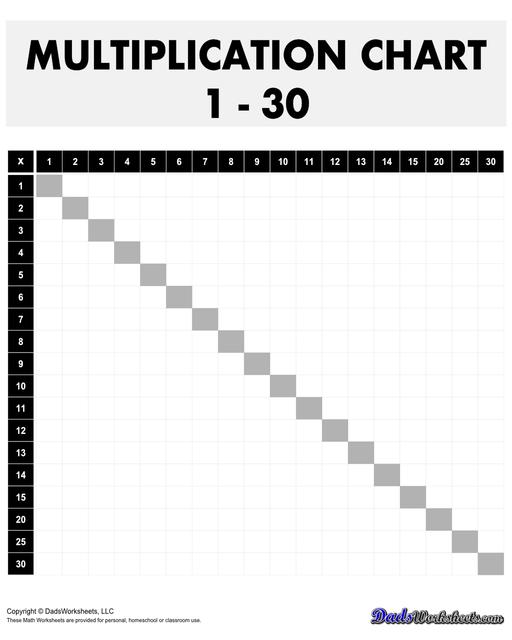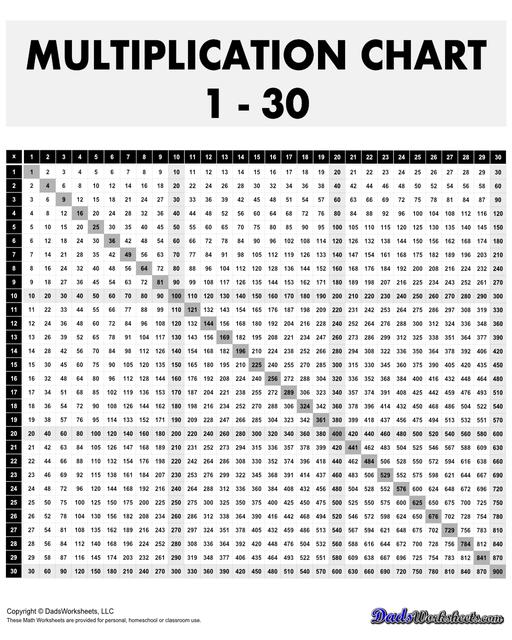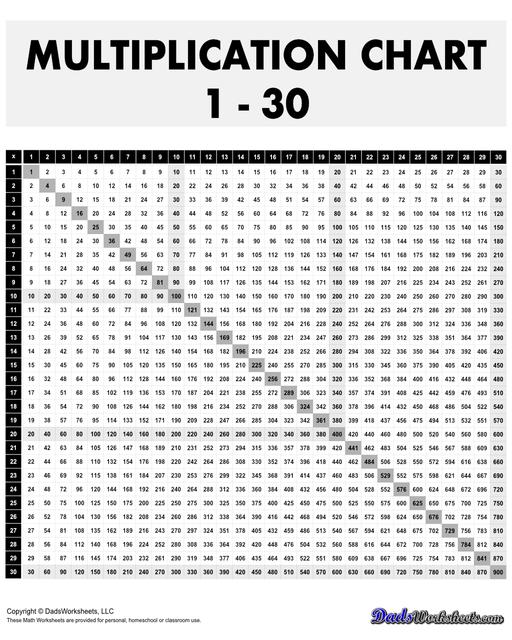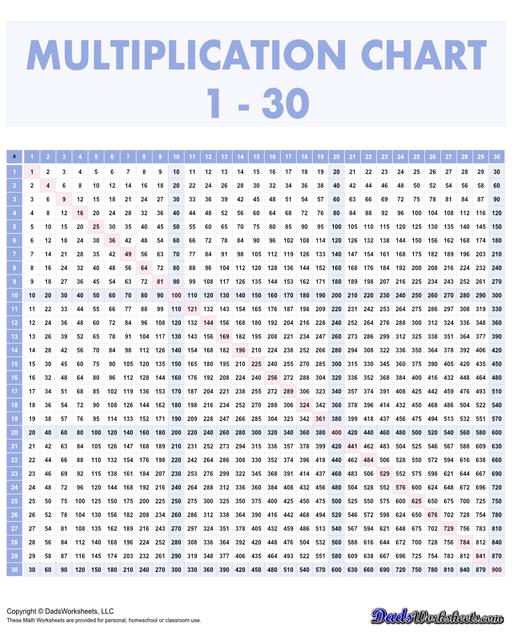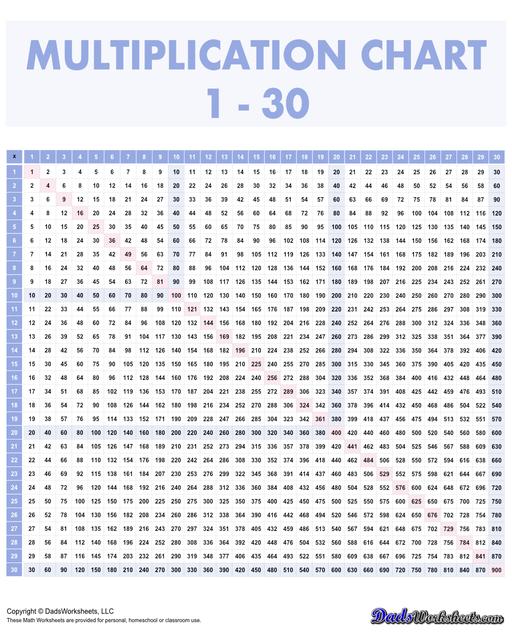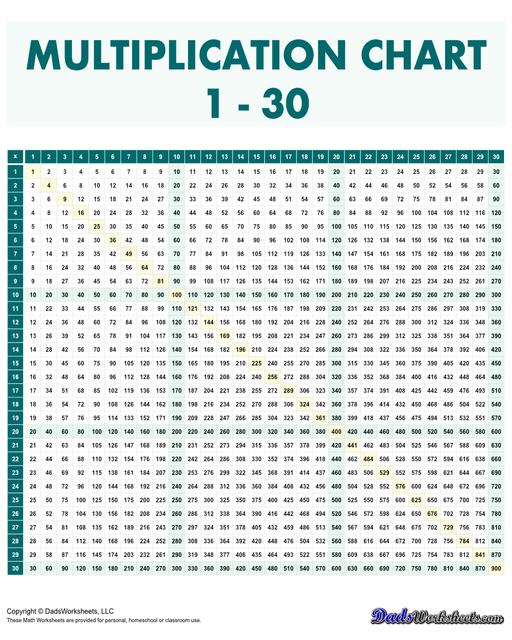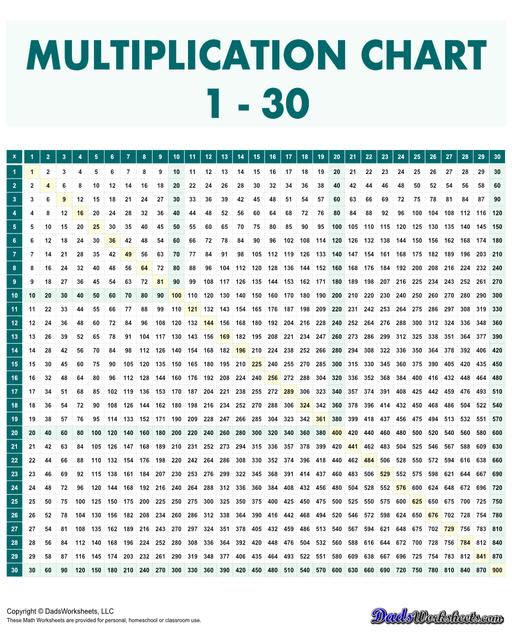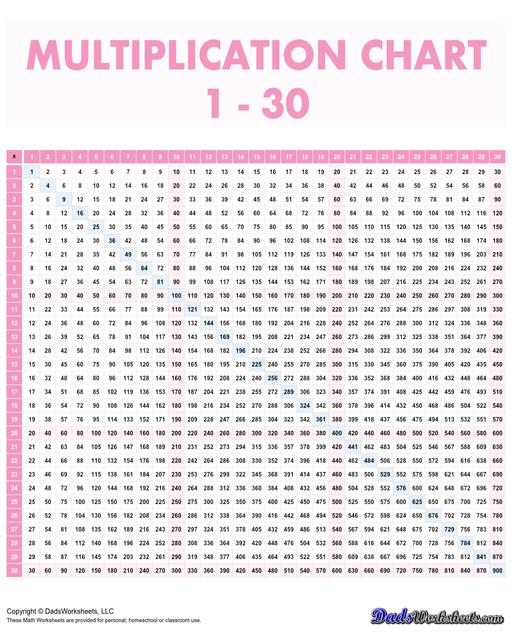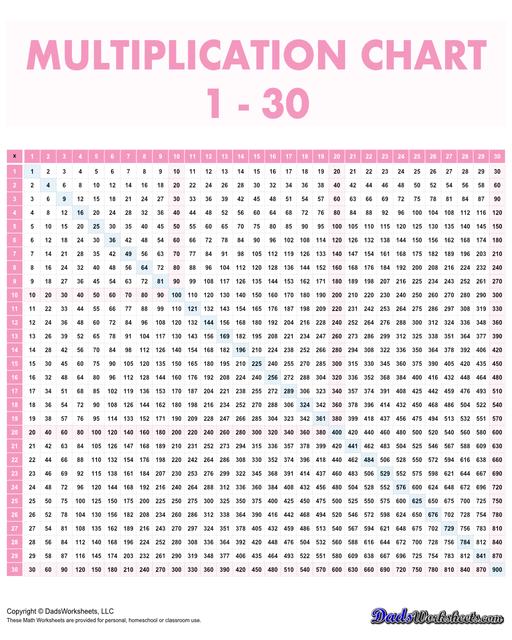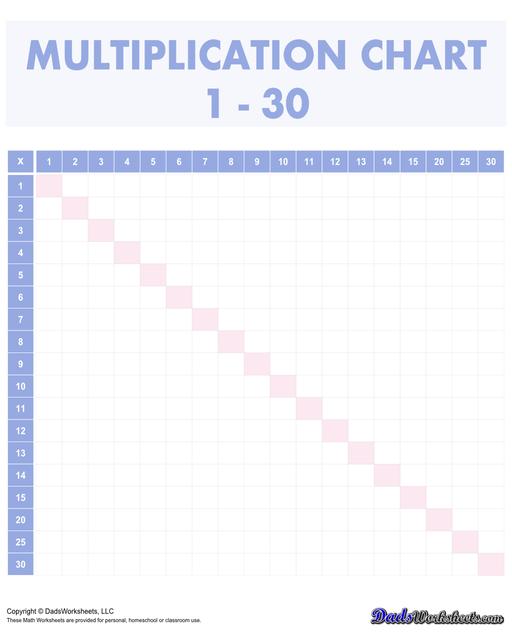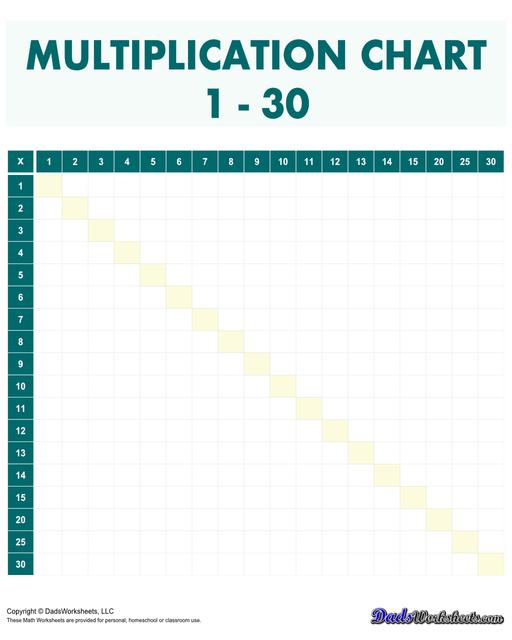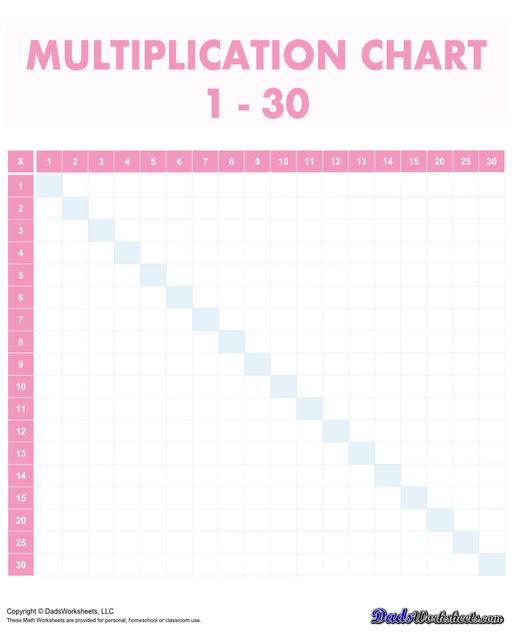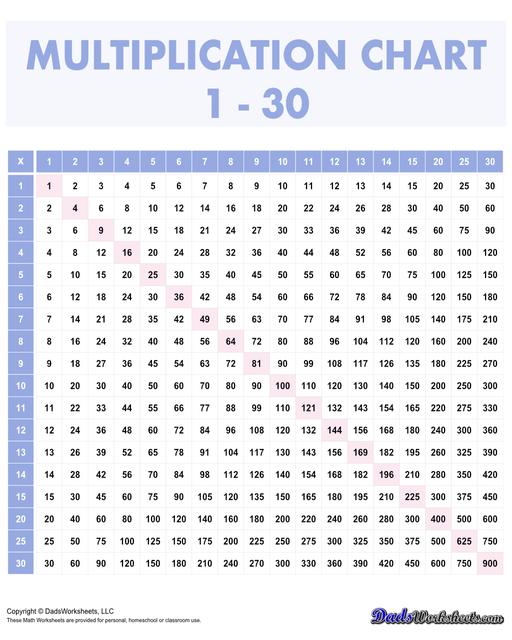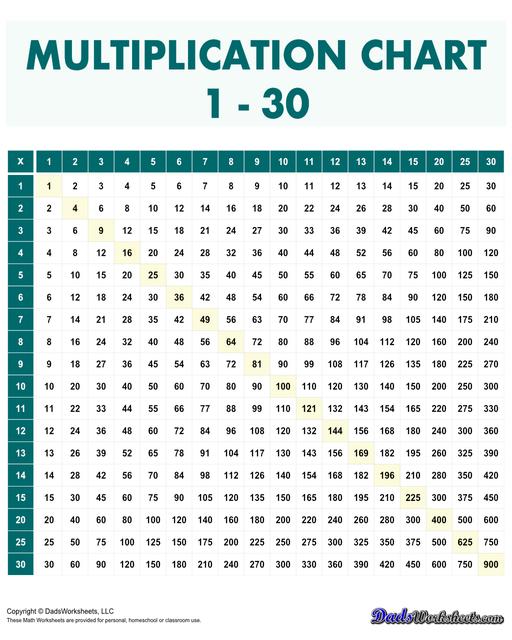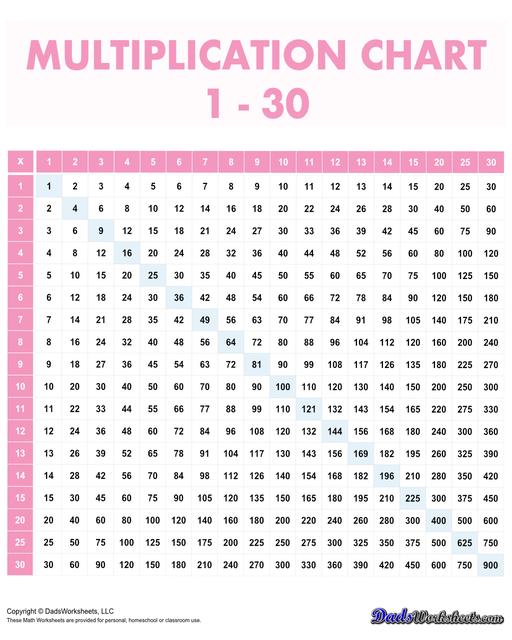Core Math Worksheets
Fraction Worksheets
Word Problems
Algebra and Trigonometry
Other Worksheets
Place Value
Percentages
Rounding Numbers
Ordering Numbers
Standard, Expanded, Word Form
Mean Median Mode Range
Ratio Worksheets
Probability Worksheets
Roman Numerals
Factorization, GCD, LCM
Prime and Composite Numbers
Pre-Algebra
Geometry Worksheets
Blank Clocks
Telling Analog Time
Analog Elapsed Time
Greater Than and Less Than
Money
Arithmetic Sequences
Geometric Sequences
Venn Diagram
Graph Worksheets
Measurement & Conversions
Patterns and Puzzles
Color by Number
Holiday & Seasonal
Early Learning
Printables
Calculators
Multiplication Chart: Multiplication Chart 30x30
A 30x30 multiplication chart provides a great way to start exploring patterns in the times table that extend past your basic 1-12 or even 1-15 facts. This printable PDF is a great tool for middle-school students who are ready to expand their multiplication skills.
Multiplication Chart 30x30
More 1 to 30 Multiplication Charts
Skip by 5 Multiplication Charts
Multiplication Chart 1-30
A 30x30 multiplication chart provides a great way to start exploring patterns in the times table that extend past your basic 1-12 or even 1-15 facts. This printable PDF is a great tool for middle-school students who are ready to expand their multiplication skills. We created different versions of the multiplication chart 1-30. You can find both black and white and pretty colorful chart designs. Each multiplication chart can be printed on one page.
Four Versions of High Quality PDF Multiplication Chart 1-30
This page has high quality printable PDF 30x30 multiplication reference charts that goes all the way to 900! This range is suitable for more advanced learners who are ready to tackle larger numbers and more complex multiplication problems. There are four versions of multiplication chart 1-30 available on this page. If you want a simple version, the black and white chart is perfect for you. If you want a little pop of color, the colored versions - blue, pink, and green, are great too! Blank versions are also available if you would like to have your students create their own multiplication charts or if you want to give them practice filling in a blank multiplication table chart. All of the charts highlight the perfect multiplication squares from 1-900. This helps students to easily navigate the multiplication chart.
Depending on your preference, this page has multiplcation charts 1-30 in diffrent designs and styles that you can easily print and use for teaching multiplication. You can also hang these multiplication charts in your kids’ room or even in your class room so that the students will have easy access and can glance at them during school days until they have memorized it by heart.
Techniques To Memorize The Multiplication Chart
We all know that multiplication lies at the core of mathematics because it serves a foundational skill in various academic and real-world contexts. While the traditional multiplication table or chart often extends only to 12, expanding it to 30 can be an enriching challenge. As the numbers in the chart increase, the calculations become more complex. Students may need to apply multiplication strategies such as regrouping, breaking numbers down into factors, or using mental math techniques to solve larger multiplication problems efficiently. I will discuss below two of the most useful techniques to help you memorize the multiplication chart from 1 to 30 or any other multiplication chart.
Identify Patterns and Relationships In a Multiplication Chart
One effective strategy for memorizing the multiplication chart is to identify patterns and relationships within the numbers. These patterns not only simplify memorization but also deepen your understanding of number properties. Analyzing the patterns and relationships within a multiplication chart can provide valuable insights into the structure of numbers and the operations of multiplication. Here are some key patterns and relationships you can identify within the numbers of a multiplication chart:
- The main diagonal line from the top left to the bottom right contains all the perfect squares and are usually highlighted in the chart. These are numbers that result from multiplying a number by itself (e.g., 1x1=1, 2x2=4, 3x3=9, and so on).
- The multiplication chart exhibits symmetry across the main diagonal. This means that the product of two numbers is the same regardless of the order in which they are multiplied. For example, 2x3=6 and 3x2=6. The commutative property of multiplication states that changing the order of the factors does not change the product. This property is evident in the multiplication chart, as each product appears twice symmetrically across the main diagonal.
- Each row and column in the multiplication chart starts with the number 1, indicating that multiplying any number by 1 results in the same number.
- Observing the pattern of multiples of 2 reveals that the ones digit alternates between 0 and 2 in each row (2, 4, 6, 8, 0, 2, 4, 6, 8, ...).
- Multiples of 5 always end in 0 or 5. This pattern is evident in the multiplication chart, where numbers in the fifth column end in 0 or 5.
- Moving diagonally from the bottom left corner to the upper right corner, the products generally increase until it reaches a perfect square, after which they start to decrease. This is because as you move further away from the perfect square along the diagonal, you're multiplying larger numbers by smaller numbers, resulting in products that are smaller than the perfect square.
- Prime numbers appear only once in the multiplication chart, as they have no factors other than 1 and themselves. Identifying prime numbers within the chart can help reinforce understanding of prime factorization and divisibility rules.
- Moving vertically in the chart corresponds to multiplying by powers of 10. Each row represents multiplication by 10, 20, 30, and so on, while each column represents multiplication by 1, 10, 100, and so on.
Divide The Entire Multiplication Chart Into Groups
Another useful technique is to divide the multiplication chart into manageable chunks or groups. Dividing the entire multiplication chart from 1 to 30 like this, for example, can help facilitate learning and memorization. Here are some ways to break it down:
- Start with the Basic Facts: Begin by focusing on the multiplication facts for smaller numbers, such as 1 through 5. These are typically easier to memorize and provide a foundation for learning larger multiplication facts.
- Chunking by Row: Divide the multiplication chart into rows, focusing on a few rows at a time. Practice the multiplication facts within each chunk until they are mastered before moving on to the next chunk. For example:
- Chunking by Column: Alternatively, divide the multiplication chart into columns, focusing on a few columns at a time. Again, practice the multiplication facts within each chunk until they are mastered before moving on to the next chunk. For example:
- Chunking by Multiples: Another approach is to group multiplication facts based on the multiples of specific numbers. A multiple is a product that we get when one number is multiplied by another number. For example, if we say 3 × 4 = 12, here 12 is a multiple of 3 and 4. Practice the multiplication facts within each chunk until they are mastered, gradually increasing the complexity by moving to higher multiples. For example:
Things to note on multiples:
- The first and smallest multiple of any number is the number itself.
- Every multiple of a number is greater than or equal to the number itself.
- If a number is a multiple of another, it will divide exactly, not leaving any remainder.
Other Multiplication Chart Printables
Looking for a other charts with more or less number values? Check out our main page for a wide variety of high quality PDF multiplication charts! Each type is tailored to the developmental level and learning needs of students at different stages of their mathematical journey.
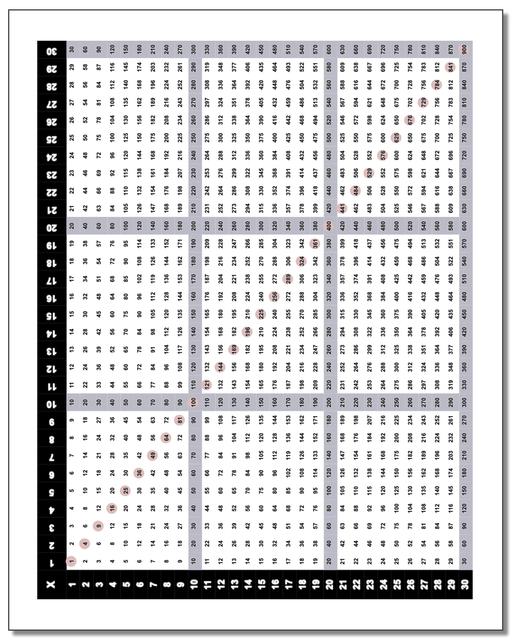
These are not the Multiplication Charts you are looking for?
Click to check out the main multiplication chart page... You'll find dozens of other options including cool color multiplication charts, multiplication charts with different ranges of products and much more...

